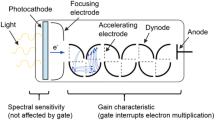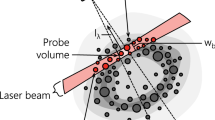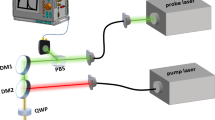Abstract
Evaluation of measurement data for laser-induced incandescence (LII) is a complex process, which involves many processing steps starting with import of data in various formats from the oscilloscope, signal processing for converting the raw signals to calibrated signals, application of models for spectroscopy/heat transfer and finally visualization, comparison, and extraction of data. We developed a software tool for the LII community that helps to evaluate, exchange, and compare measurement data among research groups and facilitate the application of this technique by providing powerful tools for signal processing, data analysis, and visualization of experimental results. A common file format for experimental data and settings simplifies inter-laboratory comparisons. It can be further used to establish a public measurement database for standardized flames or other soot/synthetic nanoparticle sources. The open-source concept and public access to the software development should encourage other scientists to validate and further improve the implemented algorithms and thus contribute to the project. In this paper, we present the structure of the LIISim software including the materials database concept, signal-processing algorithms, and the implemented models for spectroscopy and heat transfer. With two application cases, we show the operation of the software how data can be analyzed and evaluated.












Similar content being viewed by others

References
C. Schulz, B.F. Kock, M. Hofmann, H. Michelsen, S. Will, B. Bougie, R. Suntz, G. Smallwood, Appl. Phys. B 83(3), 333–354 (2006)
H.A. Michelsen, C. Schulz, G.J. Smallwood, S. Will, Prog. Energy Combust. Sci. 51, 2–48 (2015)
T. Dreier, C. Schulz, Powder Technol. 287, 226–238 (2016)
A.V. Filippov, M.W. Markus, P. Roth, J. Aerosol Sci. 30(1), 71–87 (1999)
R.L. Vander Wal, T.M. Ticich, J.R. West, Appl. Opt. 38(27), 5867–5879 (1999)
Y. Murakami, T. Sugatani, Y. Nosaka, The Journal of Physical Chemistry A 109(40), 8994–9000 (2005)
T. Lehre, R. Suntz, H. Bockhorn, Proc. Combust. Inst. 30(2), 2585–2593, (2005)
A. Eremin, E. Gurentsov, C. Schulz, J. Phys. D Appl. Phys. 41(5), 055203 (2008)
S. Maffi, F. Cignoli, C. Bellomunno, S. De Iuliis, G. Zizak, Spectrochim. Acta Part B Atomic Spectrosc. 63(2), 202–209 (2008)
T.A. Sipkens, R. Mansmann, K.J. Daun, N. Petermann, J.T. Titantah, M. Karttunen, H. Wiggers, T. Dreier, C. Schulz, Appl. Phys. B 116(3), 623–636 (2014)
K. Daun, J. Menser, R. Mansmann, S.T. Moghaddam, T. Dreier, C. Schulz, Journal of Quantitative Spectrosc. Radiat. Transfer 197, 3–11 (2017)
J. Menser, K. Daun, T. Dreier, C. Schulz, Appl. Phys. B 122(11), 277 (2016)
T.A. Sipkens, N.R. Singh, K.J. Daun, Appl. Phys. B 123(1), 14 (2017)
F. Cignoli, S. De Iuliis, V. Manta, G. Zizak, Appl. Opt. 40(30), 5370–5378 (2001)
D.R. Snelling, G.J. Smallwood, F. Liu, ÖL. Gülder, W.D. Bachalo, Appl. Opt. 44(31), 6773–6785 (2005)
T. Lehre, B. Jungfleisch, R. Suntz, H. Bockhorn, Appl. Opt. 42(12), 2021–2030 (2003)
F. Goulay, P.E. Schrader, X. López-Yglesias, H.A. Michelsen, Appl. Phys. B 112(3), 287–306 (2013)
R. Mansmann, T. Dreier, C. Schulz, Appl Opt 56(28), 7849–7860 (2017)
F. Goulay, P.E. Schrader, H.A. Michelsen, Appl. Phys. B 100(3), 655–663 (2010)
L.A. Melton, Appl. Opt. 23(13), 2201–2208 (1984)
B. Kock, B. Tribalet, C. Schulz, P. Roth, Combust. Flame 147(1–2), 79–92 (2006)
H.A. Michelsen, F. Liu, B.F. Kock, H. Bladh, A. Boiarciuc, M. Charwath, T. Dreier, R. Hadef, M. Hofmann, J. Reimann, S. Will, P.E. Bengtsson, H. Bockhorn, F. Foucher, K.P. Geigle, C. Mounaïm-Rousselle, C. Schulz, R. Stirn, B. Tribalet, R. Suntz, Appl. Phys. B 87(3), 503–521 (2007)
C. Schulz, Laser-induced incandescence: quantitative interpretation, modelling, application, in Proceedings international bunsen discussion meeting and workshop, Duisburg, Germany, 25–28 September 2005, CEUR-WS.org. http://ceur-ws.org/Vol-195. Accessed 20 Jan 2018
R. Suntz, H. Bockhorn, Laser-induced incandescence: quantitative interpretation, modelling, applications in Proceedings 2nd international discussion meeting and workshop, Bad Herrenalb, Germany, 2–4 August 2006, CEUR-WS.org. http://ceur-ws.org/Vol-211. Accessed 20 Jan 2018
P. Desgroux, Laser-induced incandescence 2012, in Proceedings 5th international workshop on laser-induced incandescence, Le Touquet, France, 8–11 May 2012, CEUR-WS.org. http://ceur-ws.org/Vol-865. Accessed 20 Jan 2018
A. Nanthaamornphong, K. Morris, D.W.I. Rouson, H.A. Michelsen, A case study: agile development in the community laser-induced incandescence modeling environment (CLiiME), in 2013 5th international workshop on software engineering for computational science and engineering (SE-CSE) (2013), pp. 9–18
A. Nanthaamornphong, J.C. Carver, K. Morris, H.A. Michelsen, D.W.I. Rouson, Comput. Sci. Eng. 16(3), 36–46 (2014)
M. Hofmann, B. Kock, C. Schulz, A web-based interface for modeling laser-induced incandescence (LIISim), in Proceedings of the European Combustion Meeting,(Kreta, 2007)
A.M. Hofmann, PhD dissertation, Heidelberg University, 2006
M. Hofmann, B.F. Kock, T. Dreier, H. Jander, C. Schulz, Appl. Phys. B 90(3–4), 629–639 (2007)
M. Leschowski, PhD dissertation, University of Duisburg-Essen, 2016
E. Cenker, G. Bruneaux, T. Dreier, C. Schulz, Appl. Phys. B 119(4), 745–763 (2015)
E. Cenker, G. Bruneaux, T. Dreier, C. Schulz, Appl. Phys. B 118(2), 169–183 (2014)
E. Cenker, K. Kondo, G. Bruneaux, T. Dreier, T. Aizawa, C. Schulz, Appl. Phys. B 119(4), 765–776 (2015)
S. Maffi, S. De Iuliis, F. Cignoli, G. Zizak, Appl. Phys. B 104(2), 357–366 (2011)
S. De Iuliis, M. Urciuolo, A. Cammarota, S. Maffi, R. Chirone, G. Zizak, XXXIV Meeting of the Italian Section of the Combustion Institute (Rome, 2011)
S. De Iuliis, F. Cignoli, G. Zizak, Appl. Opt. 44(34), 7414–7423 (2005)
T.A. Sipkens, P.J. Hadwin, S.J. Grauer, K.J. Daun, Appl Opt 56(30), 8436–8445 (2017)
C.F. Bohren, D.R. Huffman, Absorption and scattering of light by small particles. (John Wiley & Sons, 2008)
The Qt Framework, July 2015. http://www.qt.io
C. Boost, Libraries, November 2013. http://www.boost.org/
Qwt library, June 2016. http://qwt.sourceforge.net/
J.J. Moré, Numerical analysis (Springer, Berlin, Heidelberg, 1978), pp. 105–116
W.H. Press, S.A. Teukolsky, W.T. Vetterling, B.P. Flannery, Numerical recipes 3rd edition: the art of scientific computing. (Cambridge University Press, Cambridge, 2007)
ÖL. Gülder, D.R. Snelling, R.A. Sawchuk, Symp. (Int.) Combust. 26 (2), 2351–2358, (1996)
B. Quay, T.W. Lee, T. Ni, R.J. Santoro, Combust. Flame 97(3), 384–392 (1994)
J.R. Dormand, P.J. Prince, J. Comput. Appl. Math. 6(1), 19–26 (1980)
R. Lemaire, M. Mobtil, Appl. Phys. B 119(4), 577–606 (2015)
R. Mansmann, K. Thomson, G. Smallwood, T. Dreier, C. Schulz, Opt. Express 25(3), 2413 (2017)
D.R. Snelling, K.A. Thomson, F. Liu, G.J. Smallwood, Appl. Phys. B 96(4), 657–669 (2009)
R.C. Aster, B. Borchers, C.H. Thurber, Parameter estimation and inverse problems. (Elsevier Acad. Press, Amsterdam, 2005)
B.F. Kock, Zeitaufgelöste Laserinduzierte Inkandeszens (TR-LII): Partikelgrößenmessung in einem Dieselmotor und einem Gasphasenreaktor. (Cuvillier, Göttingen, 2006)
F. Liu, K.J. Daun, D.R. Snelling, G.J. Smallwood, Appl. Phys. B 83(3), 355–382 (2006)
Acknowledgements
We gratefully thank Stanislav Musikhin (University of Duisburg-Essen, Germany) for testing the software and giving helpful feedback. We acknowledge funding through the German Research Foundation via SCHU1369/14 and SCHU1369/20.
Author information
Authors and Affiliations
Corresponding author
Electronic supplementary material
Below is the link to the electronic supplementary material.
Appendices
Appendix A
1.1 Levenberg–Marquardt algorithm
For a given data vector y of the length m and for n parameters a and a vector of standard deviations \({\sigma _i}\), the residuals for a given model \({y_{{\text{mod}}}}\left( {{x_i},{\mathbf{a}}} \right)\) (spectroscopic or heat-transfer model) can be described as
and
The goal is now to minimize the nonlinear least-squares problem for the parameters a
with
The gradient of \(f\left( {\mathbf{a}} \right)\) can be written in matrix notation as
where J(a) is the Jacobian
and D half of the Hessian matrix:
For each iteration, the gradient of the parameters a can be found by solving [51]:
which can be transformed using the Cholesky decomposition to the form \({\mathbf{L}}{{\mathbf{L}}^{\text{T}}}{\mathbf{x}}={\mathbf{b}}~\) with
Now x can be found by forward \({\mathbf{Ly}}={\mathbf{b}}\) and backward substitution \({{\mathbf{L}}^{\text{T}}}{\mathbf{x}}={\varvec{y}},\) which gives the new parameter approximation for the next iteration k:
In LIISim, the parameters \({{\mathbf{a}}^{k}}\) are visualized for the temperature fit in “AnalysisTools Temperature Fit” and for the heat-transfer modeling in the FitCreator module.
Appendix B
Implemented heat-transfer models from literature [22]. The heat transfer rates are defined in the HeatTransferModel child classes in the “calculations/models/” folder of the source code.
The following materials and gas mixture properties are calculated for all models according:
Name | Variable | Symbol (original) | Symbol (LIISim) | Equation | Unit |
|---|---|---|---|---|---|
Specific heat capacity of the particle | c_p_kg | \({c_{\text{s}}}\) | \({c_{\text{p}}}\) | \({c_{\text{p}}}={C_{{\text{p}},{\text{mol}}}}/{M_{\text{p}}}\) | J kg−1 K−1 |
Thermal velocity of gas molecules | c_tg | \({c_{{\text{tg}}}}({T_{\text{g}}})\) | \({c_{{\text{tg}}}}({T_{\text{g}}})\) | \({c_{{\text{tg}}}}=~{\left( {\frac{{8~{k_{\text{B}}}{N_{\text{A}}}{T_{\text{g}}}}}{{\pi {M_{mix}}}}} \right)^{\frac{1}{2}}}\) | m s−1 |
Molar heat capacity of gas mixture | C_p_mol | – | \({C_{{\text{p,mix}}}}\) | \({C_{p,{\text{mix}}}}=\mathop \sum \limits_{i}^{n} {x_i}{C_{{\text{p}},{\text{g}},i}}\) | J mol−1 K−1 |
Heat capacity ratio | gamma | \(\gamma ({T_{\text{g}}})\) | \(\gamma ({T_{\text{g}}})\) | \(\gamma \left( {{T_{\text{g}}}} \right)=\frac{{{C_{{\text{p}},{\text{mix}}}}}}{{{C_{{\text{p}},{\text{mix}}}} - R}}\) | – |
Molar mass of gas mixture | molar_mass | – | \({M_{{\text{mix}}}}\) | \({M_{{\text{mix}}}}=\mathop \sum \limits_{i}^{n} {x_i}{M_{{\text{g}},i}}\) | kg mol−1 |
2.1 Kock model
2.1.1 Materials properties (Soot_Kock)
Name | Variable | Type | Symbol (original) | Symbol (LIISim) | a 0 | a 1 | a 2 | a 3 | a 4 | a 5 | a 6 | a 7 | a 8 | Unit | Comment |
|---|---|---|---|---|---|---|---|---|---|---|---|---|---|---|---|
Accommodation coefficient | alpha_T_eff | const | \({\alpha _{\text{T}}}\) | \({\alpha _{\text{T}}}\) | 0.23 | – | – | – | – | – | – | – | – | – | |
Accommodation coefficient | theta_e | const | \({\alpha _{\text{M}}}\) | \({\theta _{\text{e}}}\) | 1.0 | – | – | – | – | – | – | – | – | – | |
Molar heat capacity | C_p_mol | poly2a | – | \({C_{p,{\text{mol}}}}\) | 22.5566 | 0.0013 | – | – | – | − 1.8195 × 106 | – | – | – | J mol−1 K−1 | Calculated from given \({c_{\text{s}}}\) |
Total emissivity | eps | const | \(\varepsilon\) | \(\varepsilon\) | 1.0 | – | – | – | – | – | – | – | – | – | |
Molar mass | molar_mass | const | \({W_{\text{s}}}\) | \({M_{\text{p}}}\) | 0.012011 | – | – | – | – | – | – | – | – | kg mol−1 | |
Molar mass of vapor | molar_mass_v | const | \({W_{\text{v}}}\) | \({M_{\text{v}}}\) | 0.036033 | – | – | – | – | – | – | – | – | kg mol−1 | |
Density | rho_p | const | \({\rho _{\text{s}}}\) | \({\rho _{\text{p}}}\) | 1860 | – | – | – | – | – | – | – | – | kg m− 3 | |
Enthalpy of evaporation | H_v | const | \({{\Delta}}{H_{\text{v}}}\) | \({{\Delta}}{H_{\text{v}}}\) | 790776.6 | – | – | – | – | – | – | – | – | J mol− 1 | |
Reference pressure | p_v_ref | const | \({p_{{\text{ref}}}}\) | \({p_{\text{v}}}^{{\text{*}}}\) | 61.5 | – | – | – | – | – | – | – | – | Pa | Clausius–Clapeyron |
Reference temperature | T_v_ref | const | \({T_{{\text{ref}}}}\) | \({T_{\text{v}}}^{{\text{*}}}\) | 3000 | – | – | – | – | – | – | – | – | K | Clausius–Clapeyron |
2.1.2 Gas mixture properties (Kock-Nitrogen-100%)
Composition:
Gas | Variable | Symbol | Fraction |
|---|---|---|---|
Nitrogen_Kock | x | \(x\) | 1.0 |
2.1.3 Gas properties (Nitrogen_Kock)
Name | Variable | Type | Symbol (original) | Symbol (LIISim) | a 0 | a 1 | a 2 | a 3 | a 4 | a 5 | Unit |
|---|---|---|---|---|---|---|---|---|---|---|---|
Molar mass | molar_mass | const | \({M_{\text{g}}}\) | \({M_{\text{g}}}\) | 0.028014 | – | – | – | – | – | kg mol−1 |
Molar heat capacitya | C_p_mol | poly2b | \({C_{{\text{mp}},{\text{g}}}}\) | \({C_{p,{\text{g}}}}\) | 28.58 | 0.00377 | – | – | – | − 50,000 | J mol− 1 K− 1 |
2.2 Heat-transfer model (HTM_KockSoot)
Evaporation:
Conduction:
Radiation:
2.3 Liu model
2.3.1 Materials properties (Soot_Liu)
Name | Variable | Type | Symbol (original) | Symbol (LIISim) | a 0 | a 1 | a 2 | a 3 | a 4 | a 5 | a 6 | Unit | Comment |
|---|---|---|---|---|---|---|---|---|---|---|---|---|---|
Accommodation coefficient | alpha_T_eff | const | \({\alpha _{\text{T}}}\) | \({\alpha _{\text{T}}}\) | 0.37 | – | – | – | – | – | – | – | |
Accommodation coefficient | theta_e | const | \({\alpha _{\text{M}}}\) | \({\theta _{\text{e}}}\) | 0.77 | – | – | – | – | – | – | – | |
Molar heat capacity | C_p_mol | polya | \({C_{p,{\text{mol}}}}\) | 3.54288 | 3.55694 × 10− 2 | − 2.55018 × 10− 5 | 9.83713 × 10− 9 | − 2.10385 × 10− 12 | 2.35752 × 10− 16 | − 1.07879 × 10− 20 | J mol− 1 K−1 | Valid from 1200 to 5500 K; calculated from given \({c_{\text{s}}}\) | |
Total emissivity | eps | const | \(\varepsilon\) | \(\varepsilon\) | 0.4 | – | – | – | – | – | – | – | |
Molar mass | molar_mass | const | \({W_{\text{v}}}\) | \({M_{\text{p}}}\) | 0.012011 | – | – | – | – | – | – | kg mol−1 | |
Molar mass of vapor | molar_mass_v | const | \({W_1}\) | \({M_{\text{v}}}\) | 17.179 × 10−3 | 6.8654 × 10− 7 | 2.9962 × 10− 9 | − 8.5954 × 10− 13 | 1.0486 × 10− 16 | – | – | kg mol−1 | |
Density | rho_p | const | \({\rho _{\text{s}}}\) | \({\rho _{\text{p}}}\) | 1860 | – | – | – | – | – | – | kg m−3 | |
Enthalpy of evaporation | H_v | polya | \({{\Delta}}{h_{\text{v}}}\) | \({{\Delta}}{H_{\text{v}}}\) | 2.05398 × 105 | 7.366 × 102 | − 0.40713 | 1.1992 × 10− 4 | − 1.7946 × 10− 8 | 1.0717 × 10− 12 | – | J mol−1 | |
Vapor pressure | p_v | exppolyb | \({p_v}\) | \({p_{\text{v}}}\) | – | 101,325 (unit conversion) | − 122.96 | 9.0558 × 10− 2 | − 2.7637 × 10− 5 | 4.1754 × 10− 9 | − 2.4875 × 10− 13 | Pa | Original unit: [atm] from fits to data |
2.3.2 Gas mixture properties (Liu_Flame)
Composition:
Gas | Variable | Symbol | Fraction |
|---|---|---|---|
FlameAir_Liu | x | \(x\) | 1.0 |
Properties (manually set for composition):
Name | Variable | Type | Symbol (original) | Symbol (LIISim) | a 0 | a 1 | a 2 | a 3 | a 4 | Unit |
|---|---|---|---|---|---|---|---|---|---|---|
Heat capacity ratioa | gamma_eqn | polyb | \(\gamma\) | \(\gamma\) | 1.4221163416 | − 1.8636002383 × 10−4 | 8.0783894569 × 10−8 | − 1.6425082302 × 10−11 | 1.2750021975 × 10−15 | – |
2.3.3 Gas properties (FlameAir_Liu)
Name | Variable | Type | Symbol (original) | Symbol (LIISim) | a 0 | Unit |
|---|---|---|---|---|---|---|
Molar mass | molar_mass | const | – | \({M}_{\text{g}}\) | 0.02874 | kg mol− 1 |
2.4 Heat-transfer model (HTM_Liu)
Evaporation:
with \(K=0.5.\)
Conduction:
This heat-transfer model uses polynomial fitting coefficients for calculation of \(\gamma \left( T \right)\). These are provided through the “gamma_eqn” property of the LIISim implementation in the GasMixture database. If \(~~\gamma \left( T \right)\) is not defined, the heat capacity of the gas mixture \({C_{p,{\text{mix}}}}(T)\) is used to calculate \(\gamma \left( T \right)\) according to:
Radiation:
2.5 Melton model
2.5.1 Materials properties (Soot_Melton(workshop))
Name | Variable | Type | Symbol (original) | Symbol (LIISim) | a0 | Unit | Comment |
|---|---|---|---|---|---|---|---|
Accommodation coefficient | alpha_T_eff | const | \({\alpha _{\text{T}}}\) | \({\alpha _{\text{T}}}\) | 0.3 | – | |
Accommodation coefficient | theta_e | const | \({\alpha _{\text{M}}}\) | \({\theta _{\text{e}}}\) | 1.0 | – | |
Molar heat capacity | C_p_mol | const | – | \({C_{p,{\text{mol}}}}\) | 22.8 | J mol−1 K−1 | acalculated from given \({c_{\text{s}}}\) |
Molar mass | molar_mass | const | \({W_{\text{s}}}\) | \({M_{\text{p}}}\) | 0.012 | kg mol− 1 | |
Molar mass of vapor | molar_mass_v | const | \({W_{\text{v}}}\) | \({M_{\text{v}}}\) | 0.036 | kg mol− 1 | |
Density | rho_p | const | \({\rho _{\text{s}}}\) | \({\rho _{\text{p}}}\) | 2260 | kg m− 3 | |
Enthalpy of evaporation | H_v | const | \({{\Delta}}{H_{\text{v}}}\) | \({{\Delta}}{H_{\text{v}}}\) | 7.78 × 105 | J mol− 1 | |
Reference pressure | p_v_ref | const | \({p_{{\text{ref}}}}\) | \({p_{\text{v}}}^{{\text{*}}}\) | 100,000 | Pa | Clausius–Clapeyron |
Reference temperature | T_v_ref | const | \({T_{{\text{ref}}}}\) | \({T_{\text{v}}}^{{\text{*}}}\) | 3915 | K | Clausius–Clapeyron |
2.5.2 Gas mixture properties (Melton-Nitrogen-100%)
Composition:
Gas | Variable | Symbol | Fraction |
|---|---|---|---|
Nitrogen_Melton | x | \(x\) | 1.0 |
Properties (manually set for composition)
Name | Variable | Type | Symbol (original) | Symbol (LIISim) | a 0 | a 1 | Unit | Comment |
|---|---|---|---|---|---|---|---|---|
Thermal conductivity | therm_cond | const | \({\kappa _{\text{a}}}\) | \({\kappa _{\text{a}}}\) | 0.1068 | – | W/m/K | Original unit W/cm/K |
Mean free path | L | polya | \(L\) | \(L\) | – | 2.355 × 10−10 | m | Original unit: cm |
2.5.3 Gas properties (Nitrogen_Melton)
Name | Variable | Type | Symbol (original) | Symbol (LIISim) | a0 | Unit | Comment |
|---|---|---|---|---|---|---|---|
Molar heat capacity | C_p_mol | const | \(-\) | \({C_{{\text{p,g}}}}\) | 36.0295 | J mol−1 K−1 | a calculated from given\(\gamma (1800\;{\text{K}})=1.3\) |
2.6 Heat-transfer model (HTM_Melton)
Evaporation:
This model uses molar mass of solid species in Eq. (35).
Conduction:
Radiation:
Not included in this model.
Rights and permissions
About this article
Cite this article
Mansmann, R., Terheiden, T., Schmidt, P. et al. LIISim: a modular signal processing toolbox for laser-induced incandescence measurements. Appl. Phys. B 124, 69 (2018). https://doi.org/10.1007/s00340-018-6934-9
Received:
Accepted:
Published:
DOI: https://doi.org/10.1007/s00340-018-6934-9



